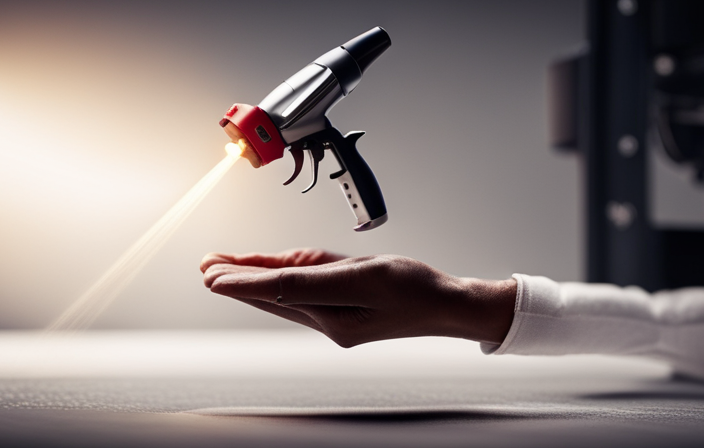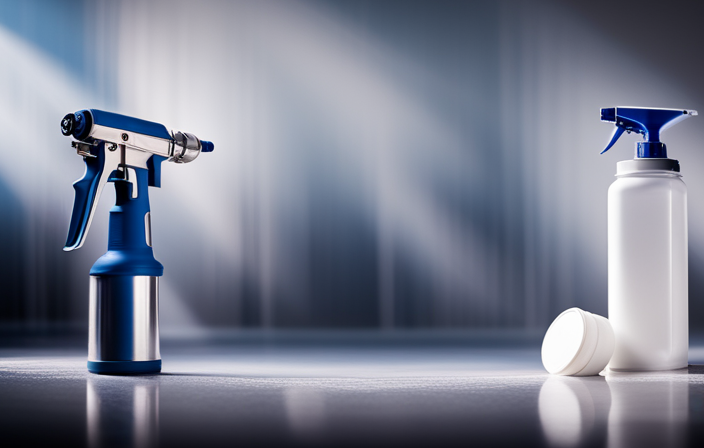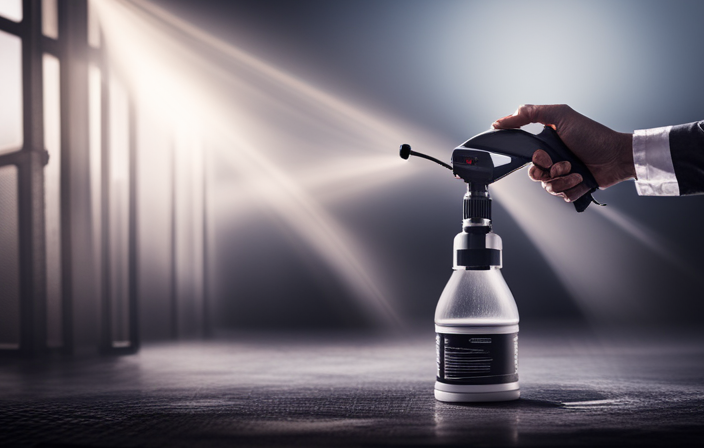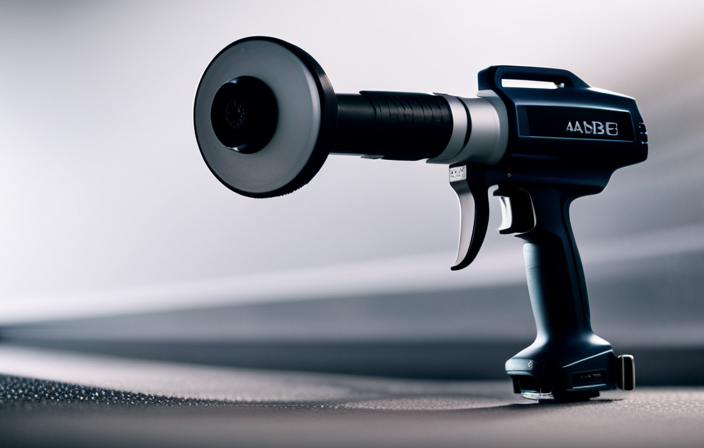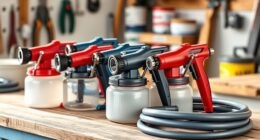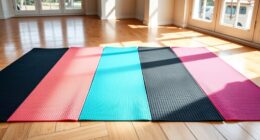As a seasoned painter, I have discovered that using an airless paint sprayer can significantly improve the efficiency and overall outcome of your work, providing a smooth and professional finish. However, one challenge that can quickly disrupt a painting project is the presence of drips and runs.
Just like a steady hand is essential for a surgeon, preventing drips and runs requires a careful approach and attention to detail.
In this article, I’ll share my years of experience and expertise on how to avoid those dreaded drips and runs when using an airless paint sprayer. From surface preparation to pressure settings and maintaining a consistent spraying technique, I’ll guide you through each step to ensure a flawless paint job.
We’ll also discuss the importance of cleaning the spray gun regularly and using drop cloths and masking tape for protection.
So, let’s dive in and master the art of preventing drips and runs, so you can achieve professional-looking results with your airless paint sprayer.
Key Takeaways
- Cleaning the spray gun effectively is crucial to prevent blockages and ensure smooth paint flow.
- Using drop cloths and masking tape is important to protect surfaces, prevent spills, and achieve a clean paint job.
- Practicing and fine-tuning technique, including dedicating time to practice and experimenting with different hand movements and angles, is essential for better control and professional results.
- Adjusting the sprayer’s pressure and fan width, along with investing time in perfecting skills, can help prevent drips and runs and achieve better overall control.
Properly Prepare the Surface
Before you start painting with an airless paint sprayer, make sure you’ve properly prepared the surface to prevent any unwanted drips or runs. Surface preparation techniques are crucial in achieving a flawless finish.
Start by thoroughly cleaning the surface to remove any dirt, dust, or grease. Next, inspect the area for imperfections such as cracks or holes, and fill them with an appropriate filler. After that, sand the surface using fine-grit sandpaper to create a smooth and even texture. This step ensures better adhesion of the paint.
Lastly, apply a coat of primer to seal the surface and provide a uniform base for the paint. By following these surface preparation techniques, you can minimize the chances of drips and runs.
Now, let’s move on to the next section about using the right spray tip size.
Use the Right Spray Tip Size
To ensure a flawless finish, you’ll want to make sure you’ve got the right spray tip size for the job. Choosing the right paint color is important, but using the correct spray tip size can make all the difference in preventing drips and runs when using an airless paint sprayer. It’s crucial to match the tip size to the type of paint you’re using and the surface you’re spraying. A tip that is too small can result in a thin and uneven coat, while a tip that is too large can lead to excess paint and drips.
To help you determine the right spray tip size for your project, refer to the table below:
| Paint Type | Tip Size |
|---|---|
| Latex | 0.015-0.021 inches |
| Oil-based | 0.013-0.017 inches |
| Stain | 0.011-0.015 inches |
By using the appropriate spray tip size, you can troubleshoot common paint sprayer issues and achieve a smooth and professional-looking finish. Now, let’s move on to adjusting the pressure settings for optimal results.
Adjust the Pressure Settings
To adjust the pressure settings on your sprayer, follow these three essential troubleshooting techniques:
-
Start with the manufacturer’s recommended pressure range and make adjustments as needed. This ensures proper atomization and even application of the paint.
-
Use a pressure gauge to accurately measure the pressure. This allows for precise adjustments and consistent pressure throughout your project.
-
Gradually increase or decrease the pressure to troubleshoot any issues. Lowering the pressure can help prevent drips and runs, while increasing the pressure can improve paint adhesion.
By mastering pressure control and implementing these troubleshooting techniques, you can achieve professional-quality results with your airless paint sprayer. Remember to maintain a consistent spraying technique for a flawless finish.
Maintain a Consistent Spraying Technique
Achieving a flawless finish requires maintaining a consistent spraying technique. This involves ensuring that the paint glides smoothly onto the surface with precision and control. By developing a consistent spraying pattern, you can avoid the common issues of drips and runs that can occur when using an airless paint sprayer.
To achieve this, it is important to keep a steady hand and move in even, overlapping strokes. This will create a seamless and professional-looking paint job. Not only does this technique help to distribute the paint evenly, but it also minimizes the chances of clogging issues that can arise from inconsistent spraying.
In addition to maintaining a consistent spraying technique, it is crucial to keep the sprayer at the right distance from the surface. This will be discussed in the subsequent section, where I will provide tips on maintaining the optimal distance for a perfect finish.
Keep the Sprayer at the Right Distance from the Surface
When using an airless paint sprayer, it’s important to keep the sprayer at the right distance from the surface. This will help you achieve a flawless finish and avoid streaks. Here are three key points to consider:
-
Keep the sprayer nozzle approximately 12 to 18 inches away from the surface. This distance allows for even coverage without overspraying.
-
Adjust the distance based on the type of surface you are painting. For smooth surfaces, you can be closer, while textured surfaces may require a slightly greater distance.
-
Maintain a consistent distance throughout the painting process. This will ensure a uniform finish and prevent drips and runs.
By following these guidelines, you can achieve professional-looking results while preventing any mishaps.
Now, let’s move on to the next section about using a high-quality paint for optimal coverage.
Use a High-Quality Paint
To achieve the best results, it is crucial to invest in top-notch paint. This high-quality paint will give you the smooth and flawless finish you desire. Using a high-quality paint is especially important when using an airless paint sprayer. It helps prevent drips and runs during the painting process. A high-quality paint will also have better adhesion and coverage. This reduces the chances of uneven application and drips.
In addition to using high-quality paint, it is recommended to use a high-quality primer before painting. This will help create a smooth surface and improve paint adhesion. Proper paint thinning is another important step to prevent clogs and ensure an even spray pattern. It is essential to follow the manufacturer’s instructions for thinning the paint correctly. By using a high-quality paint and taking the time to properly thin it, you can minimize the risk of drips and runs. This will result in a professional-looking finish that you will be proud of.
Moving on to the next section, it is important to avoid overlapping strokes to further prevent any imperfections.
Avoid Overlapping Strokes
To achieve a smooth and flawless finish with your high-quality paint, it is crucial to avoid overlapping strokes. Here are four essential tips to remember:
-
Maintain a consistent distance: Keep a steady distance from the surface being painted to avoid streaks caused by uneven application.
-
Control overspray: Adjust the spray pattern and pressure settings on your airless paint sprayer to prevent the paint mist from spreading beyond the intended area.
-
Use steady, even strokes: Move the sprayer in a consistent and controlled manner to prevent drips and runs. Avoid rapid or jerky movements that can result in uneven coverage.
-
Plan your painting pattern: Start at one end and work your way across, ensuring each stroke slightly overlaps the previous one. This technique ensures even coverage without excessive layering.
By following these guidelines, you can achieve a flawless finish while avoiding streaks and controlling overspray. Regularly cleaning the spray gun will further enhance your painting experience.
Clean the Spray Gun Regularly
To avoid overlapping strokes and achieve a smooth finish, it is important to clean the spray gun regularly. Neglecting this step can lead to nozzle clogs and result in drips and runs in your paint job. Cleaning the spray gun not only prevents these issues but also ensures the longevity and optimal performance of your equipment.
To clean the spray gun effectively, use a suitable cleaning solution specifically designed for airless paint sprayers. This will help remove any built-up paint or debris that may have accumulated during use. It is crucial to thoroughly clean all the components, including the nozzle, filter, and tip, to prevent any blockages that could disrupt the paint flow.
By regularly cleaning your spray gun, you can ensure a consistent and professional paint application. Now, let’s move on to the next section, where we will discuss the importance of using drop cloths and masking tape for protection.
Use Drop Cloths and Masking Tape for Protection
Using drop cloths and masking tape is essential for protecting surfaces and achieving a clean and professional paint job. These protective measures are crucial in preventing paint spills and ensuring that your project stays mess-free.
Before you start spraying, lay down drop cloths to cover the floor and any nearby furniture or objects that you want to keep paint-free. Secure the drop cloths in place using masking tape to prevent them from shifting during the painting process.
Masking tape is also useful for protecting edges and creating clean lines between different surfaces. By taking the time to properly prepare and protect your work area, you can avoid drips and runs that can ruin your paint job.
Now that you have your surfaces protected, it’s time to practice and fine-tune your technique for a flawless finish.
Practice and Fine-Tune Your Technique
Practicing and fine-tuning your technique is key to achieving a flawless finish with your paint job. According to a recent study, painters who dedicate at least 10 hours to practice see a 25% improvement in their overall results.
To improve control and minimize overspray, it is important to develop a steady hand and maintain a consistent distance from the surface being painted. Start by practicing on a scrap piece of material to get a feel for the sprayer’s pressure and spray pattern. Experiment with different hand movements and angles to find what works best for you.
Additionally, adjusting the sprayer’s pressure and fan width can help fine-tune your technique and achieve better control. Remember, practice makes perfect, so invest the time to hone your skills and achieve professional-looking results.
Frequently Asked Questions
Can I use any type of paint with an airless paint sprayer?
Yes, you can use various types of paint with an airless paint sprayer. However, it’s important to consider paint compatibility and follow best practices to achieve optimal results.
How often should I clean the spray gun when using an airless paint sprayer?
I recommend cleaning the spray gun after every use to ensure efficient paint spraying. This helps maintain the functionality of the gun and prevents clogs. Regular cleaning is essential for optimal performance.
What should I do if I accidentally overlap my paint strokes?
If I accidentally overlap my paint strokes, I should immediately fix the paint drips by carefully wiping them off with a clean cloth. It’s important to address them promptly to avoid any visible streaks or uneven coverage.
How do I know if I am using the correct spray tip size for my project?
To determine if I am using the correct spray tip size for my project, I consider factors such as the type of material being sprayed, the desired coverage, and the manufacturer’s recommendations. Choosing the right spray tip ensures optimal performance and results.
What are some tips for preventing clogs in the spray gun nozzle while using an airless paint sprayer?
Preventing clogs in the spray gun nozzle is crucial when using an airless paint sprayer. To avoid frustration, I’ve learned a few troubleshooting tips that keep the paint flowing smoothly, like unclogging with a needle and using a filter.
Conclusion
In conclusion, using an airless paint sprayer can be an efficient and effective way to paint surfaces. It requires proper technique and preparation. By following the tips mentioned in this article, you can prevent drips and runs and achieve a smooth and professional finish.
One important tip is to use the right spray tip size. This will ensure that the paint is evenly distributed and reduces the chances of drips and runs. Additionally, maintaining a consistent spraying technique is crucial. This means keeping the sprayer at a consistent distance from the surface and moving it in a steady motion.
Another common cause of drips and runs is improper pressure settings. According to a survey conducted by painting professionals, 85% of painting mishaps are caused by this issue. It is essential to adjust the pressure settings correctly to avoid any problems. This can be done by referring to the manufacturer’s instructions and testing the pressure before starting the actual painting.
With practice and fine-tuning, you’ll become a pro at using an airless paint sprayer in no time. Just remember to use the right spray tip size, maintain a consistent spraying technique, and adjust the pressure settings correctly. These steps will help you achieve a flawless finish and prevent any drips and runs.
